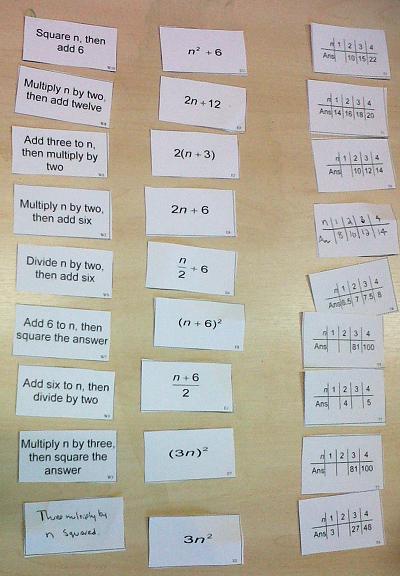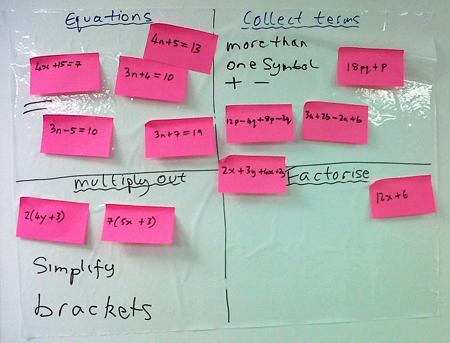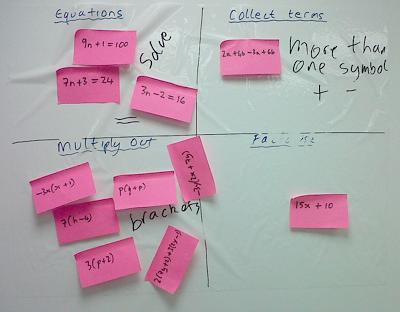
[ home ]
I've been using card sorting and activities based on posting sticky notes on prepared templates as activities at the beginning and end of classes. These activities seem to clue people in and allow them to remember the meta-information that goes with problem solving more effectively. This page summarises some approaches that I have used.
Card sorting is definitely a pairs activity, or groups of three at a stretch provided you can arrange for the group of three to face each other. Three in a line means the middle person has to act as a telephone exchange! Cards work best when laminated, so preparation can take time if you have classes of 20+ as I do. I'm developing the use of sticky note sorting activities as a quick to prepare alternative that can be used with large groupings - almost stand up meetings in the class.
These sorting activities are really useful when you have to teach students how to classify cases or how to match typical values to different measurements.

I used my graph sorting cards last week (printed 4 to an A4 sheet and laminated) in this year's AQA Unit 2 revision session. The students were sorting the cards into positive and negative gradient and positive and negative intercept and then finding the values of these parameters. Then they wrote down the formulas for the graphs by answering questions on a simple response sheet. The ability to move the cards around and directly to compare pairs and quads of graphs all drawn to the same scale seems to help students to identify the gradient and intercept more easily, and to form categories to classify the lines into. There was a lot of discussion going on while sorting the cards, and we know that talking about maths is a good thing for students to do. Pairs were asked directed questions about their choices so other pairs could see the card arrangement
The metric measurements card sort worked well with two different Functional Skills Maths Level 1 classes, but as a pairs activity. Students had filled in a metric survey sheet the week before, so had looked in their food cupboards, bathroom cabinets and garages and found out various items and written down the metric quantities from the packets. As a result each pair was able to match the image with a typical metric quantity. The harder cards proved to be the 10ml syringe and the tea and table spoons. Informal conferring between pairs was allowed!


Laminating sets of cards can take a long time, so I've started using sticky notes that students sort into categories drawn up on two dry wipe boards, I actually use a few sheets of magic whiteboard placed on the same long wall.
I've described the first use of sticky notes as part of a probability lesson to cover the questions where students have to categorise events as imposible, unlikely, evens, likely or certain. A common mistake is categorising 'roll a 5 on a fair dice' as 'likely'. The digit 5 is just a label on one of the six sides of the dice.
A second use of sticky notes was to classify a series of algebraic expressions and equations, a simpler version of my algebra revision exercise for students relearning algebra for the first time this year. I wrote equations on some of the sticky notes and on the others I wrote expressions including collecting like terms; multiplying out brackets and factorising. I wrote a mix of easy, medium and reasonably complex (for Foundation GCSE) expressions and distributed them to match the 'usual' seats of various members of the class, so 10 minutes set up time for the sticky notes and putting up the magic whiteboards with simple categories as opposed to an hour for laminating a set of cards.
When students arrived, I had a quick question sheet ready to tune them in while I set up the PC and loaded the interactive whiteboard screens up for the session. Then once we had read through the 'must, should, could' objectives for the lesson, I started the sorting activity. The back two rows used the second magic whiteboard and the front two rows used the front magic whiteboard. Everyone has been working individually for 15 minutes or so and is now standing up and sticking notes. Some notes are incorrectly categorised, but other people reposted them! Much less discussion compared with the pairs based card sort, this activity emphasises recall and classification.
I then talked through the activity standing between the two groups of people standing round the whiteboards and we identified...
Then we sat down, and I summarised the findings on a whiteboard slide. Total class time about 25 minutes including objectives of lesson, and how to differentiate the expressions into three difficulty levels. The rest of the session was taken up with must, should, could worksheets downloaded from the TES Maths resources bank (including the ever useful Mr Barton Maths resources) and skills building worksheets taken from the Edexcel teacher's guide.
As we approach revision time, I shall start using activities where students write the sticky notes themselves.
I suspect the effectiveness of these activities stems from
The sticky notes version of the sorting task allows the tutor to see what differences and similarities the students are seeing, and to correct and question the students. I have noticed that students seem more ready to answer and ask questions when we are standing in groups looking at a display than when I am up at the front and they are sitting down in the body of the classroom. I imagine using these sticky note tasks at the start of a session to 'tune' people into the lesson, and at the end of the session as a summary of learning.
I plan to run the VARK learning styles questionnaire with the group to see if we have strongly kinaesthetic learners or if the modalities are more evenly distributed. The students may benefit from the study skills suggestions that follow from completing the questionnaire as we approach the final topics on the syllabus and begin revision. Pilot use of the VARK survey with about 20 students suggests a fair number of multimodal learning, and quite a few responses where one modality is much less highly scored than the other three.
Keith Burnett, Last update: Sun Feb 17 2013